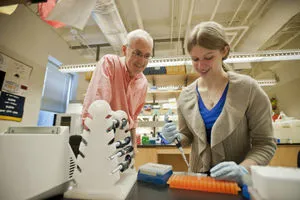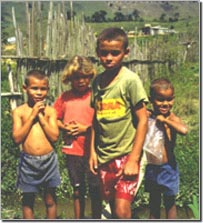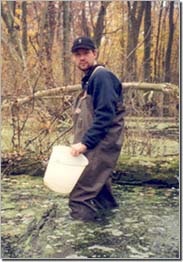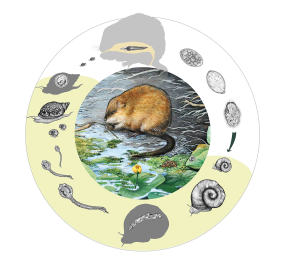Drawing upon both molecular and experimental field approaches, research in my laboratory focuses on the population biology, evolution, and genetics of host-parasite interactions. The research program encompasses 1) host-parasite coevolution, 2) parasite competition and the evolution of virulence, 3) genetic heterogeneity and the structure of parasite populations, 4) gene transfer between parasites and their hosts, and 5) Parasites within communities and ecosystems.
Host-Parasite Coevolution
Variation in host life history patterns may be a result of a parasite adaptation, a host adaptation or a non-adaptive side effect of the interaction. Genetic heterogeneity of hosts and parasites fuels the coevolutionary arms race leading to an array of varied outcomes. In the coevolutionary interactions between participants, hosts respond to parasite selective pressures by evolving mechanisms for evading, counteracting, or minimizing the negative fitness effects of parasitism. We have suggested that a host may be able to modify the outcome of a parasitic infection either 1) by resisting infection via initiation of immune responses or 2) by varying other life-history parameters (Minchella ,1985 paper with nearly 300 citations). The degree to which hosts exhibit these responses depends not only on the force of infection, but also the prevailing environmental conditions. The traditional view is that hosts prevent infection through genetically-based resistance to parasites, but resistance is generally regarded as a costly undertaking that results in trade-offs with other life history traits. One thrust of this laboratory is to assess the potential costs of resistance under varying biotic and abiotic conditions. Alternatively, hosts may alter infection outcomes by varying other (non-immunological) life-history characters, which may be less costly than resistance. Using the snail-trematode system as a model, we have been exploring the range of tactics utilized by molluscan hosts, including changes in reproductive output, survivorship, and growth.
- Jones-Nelson, O., E.A. Thiele, and D.J. Minchella. 2011. Transmission dynamics of two strains of Schistosoma mansoni utilizing novel intermediate and definitive hosts. Parasitology Research 109:675-687.
- Yiding, Y., Z. Feng, D. Xu, G. J. Sandland, and D.J. Minchella. 2012. Evolution of host resistance to parasite infection in the snail-schistosome-human system. Journal of Mathematical Biology 65:201-236.
- Gleichsner, A., J. Cleveland, and D.J. Minchella. 2016. One stimulus – two responses: host and parasite life history variation in response to environmental stress. Evolution. 70-11: 2640-2646.
Parasite Competition and the Evolution of Virulence
Inter- and intra-specific competition between parasites within a host can have implications for disease intensity and parasite transmission. Kin selection theory predicts that the genetic relatedness of co-infecting parasites will determine whether they are more or less damaging to their host (virulence). Additionally, factors that influence the genetic composition of a parasite infection, such as host movement or resistance, can influence the evolution of disease in parasite populations. This laboratory uses a mixture of field, molecular, and life history measurements to better understand the impacts that parasite competition has on transmission and disease severity. We use laboratory and field studies to examine how the genetic relatedness of a parasite infection influences disease outcomes and observe changes in co-infections over time.
- Thiele, E.A. and D.J. Minchella. 2013. Molecular assessment of trematode coinfection and intraspecific competition in molluscan intermediate hosts. Molecular and Biochemical Parasitology 187:52-59.
- Gleichsner, A. and D.J. Minchella. 2014. Can host ecology and kin selection predict parasite virulence? Parasitology 141:1018-1030.
- Gleichsner, A.M., K. Reinhart*, and D.J. Minchella. 2018. Of mice and worms: Are co-infections with unrelated parasite strains more damaging to definitive hosts? International Journal of Parasitology 48:881-885.
Genetic Heterogeneity and the Structure of Parasite Populations
Interactions between trematodes and their snail hosts play an important role in the development of the host and parasite genetic systems. The extent of genetic heterogeneity in local parasite populations has implications on the epidemiology of host disease. Blood flukes of the genus Schistosoma cause human schistosomiasis, a disease affecting more than 200 million patients worldwide. This parasite exhibits significant phenotypic differences within and among geographic populations, yet the degree of genetic variability in both the parasite and its host snails remains largely unknown. Our laboratory has been a leader in the study of natural diversity of these parasites. Heterogeneity of schistosome populations in nature is difficult to study due to the location of the adult worms within the human blood system and the small size of the larval stages associated with transfer between hosts. We have been able to circumvent these difficulties by using molecular markers to quantify the degree of host and parasite genetic heterogeneity in natural populations and to determine how that variation changes on a spatial and temporal scale.
- Thiele, E.A., G. Correa-Oliveira, A. Gazzinelli, and D.J. Minchella. 2013. Elucidating the temporal and spatial dynamics of Biomphalaria glabrata genetic diversity in three Brazilian villages. Tropical Medicine and International Health 18:1164-1173.
- Gleichsner, A., E.A. Thiele, and D.J. Minchella. 2015. It’s all about those bases: the need for incorporating parasite genetic heterogeneity into the development of schistosome vaccines. PLoS Neglected Tropical Diseases 9: Article number: e0003805.
- Wijayawardena, B.K., D.J. Minchella, and J.A. DeWoody. 2016. The influence of trematode parasite burden on gene expression in a mammalian host. BMC Genomics (2016) 17:600.
Gene Transfer Between Parasites and Their Hosts
It is long been known that bacteria can swap genes between each other by a process known as “horizontal gene transfer”. Today, the evidence shows that animals and plants also have the ability to exchange genes. In fact, animal and plant parasites can act as vectors, transferring genes between hosts. The number of reports of parasite mediated horizontal gene transfer is growing, but some of these reports need to be validated using more rigorous methods. Sequence similarity and phylogenetic incongruence have been widely used to identify gene transfers. We have examined past studies to identify supported gene transfer events and are working to promote the use of genome sequencing, as well as ecological and geographical compatibility of “gene donors” and “gene recipients” in substantiating gene transfers.
- Wijayawardena, B.K., D.J. Minchella, and J.A. DeWoody. 2013. Hosts, parasites, and horizontal gene transfer. Trends in Parasitology 29:329-338.
- Wijayawardena, B.K., D.J. Minchella, and J.A. DeWoody. 2015. Horizontal gene transfer in schistosomes: a critical assessment. Molecular and Biochemical Parasitology 201: 57-65.
- Wijayawardena, B.K., J.A. DeWoody, and D.J. Minchella. 2015. The genomic proliferation of transposable elements in colonizing populations: Schistosoma mansoni in the new world. Genetica 143:287-298.
Parasites within Communities and Ecosystems
Parasites are increasingly recognized as pivotal and often cryptic members of communities and ecosystems. Despite the impacts of various parasites on host behavior and physiology, little is known about how these impacts radiate outwards across multiple levels of biological organization. Grounded in ecological stoichiometry and metabolic theory, we explore how parasites change hosts’ use and distribution of nutrients within and between ecosystems. These changes to nutrient dynamics can manifest as nutrients stored within host/parasite tissue and nutrients moved within/between ecosystems. Using modelling, field, and laboratory approaches, we examine when, where and how much parasites may impact community and ecosystem structure.
- Vannatta, J.T. and D.J. Minchella. 2018. Parasites and their impact on ecosystem nutrient cycling. Trends in Parasitology 34(6): 452-255.
- Minchella, D.J. and M.E. Scott. 1991. Parasitism: A cryptic determinant of community structure. Trends in Ecology and Evolution 6:250-254.



